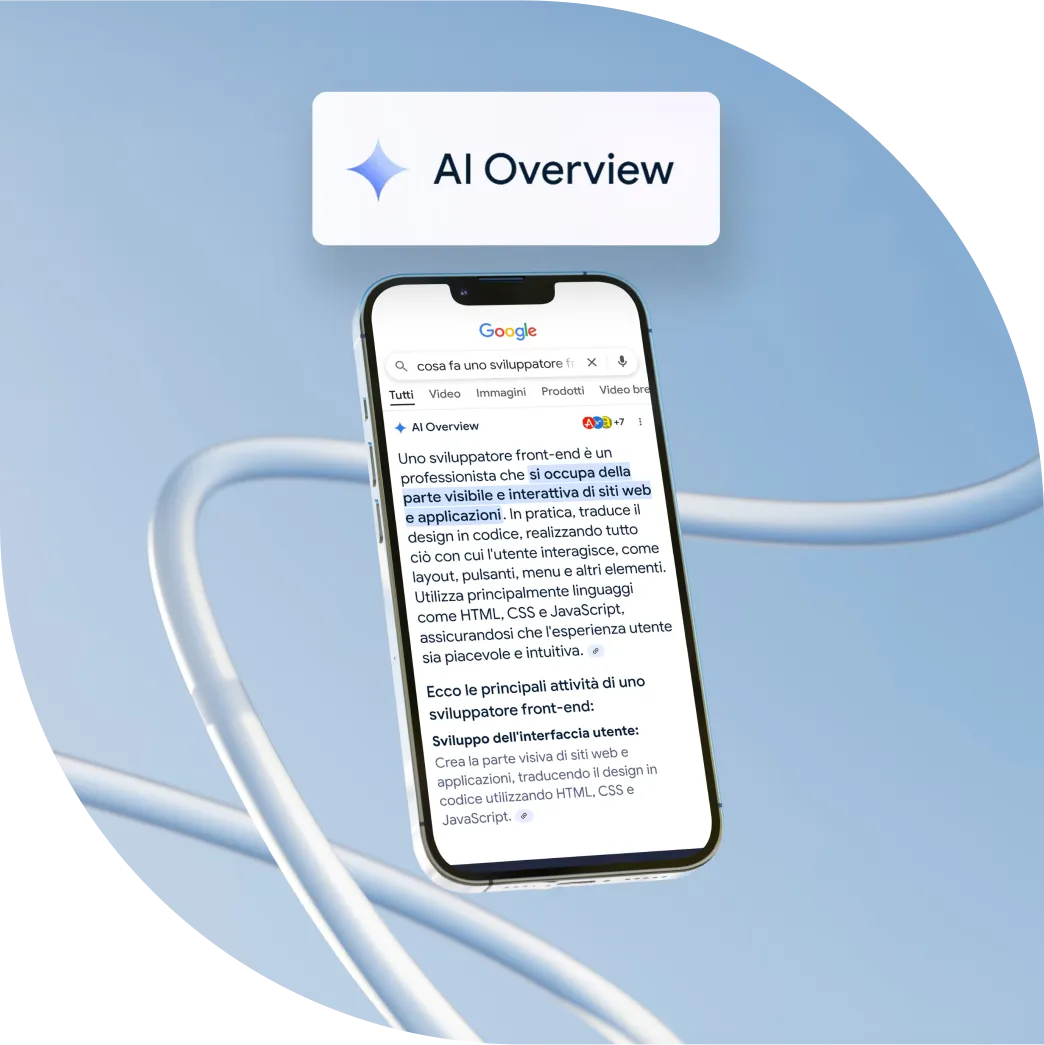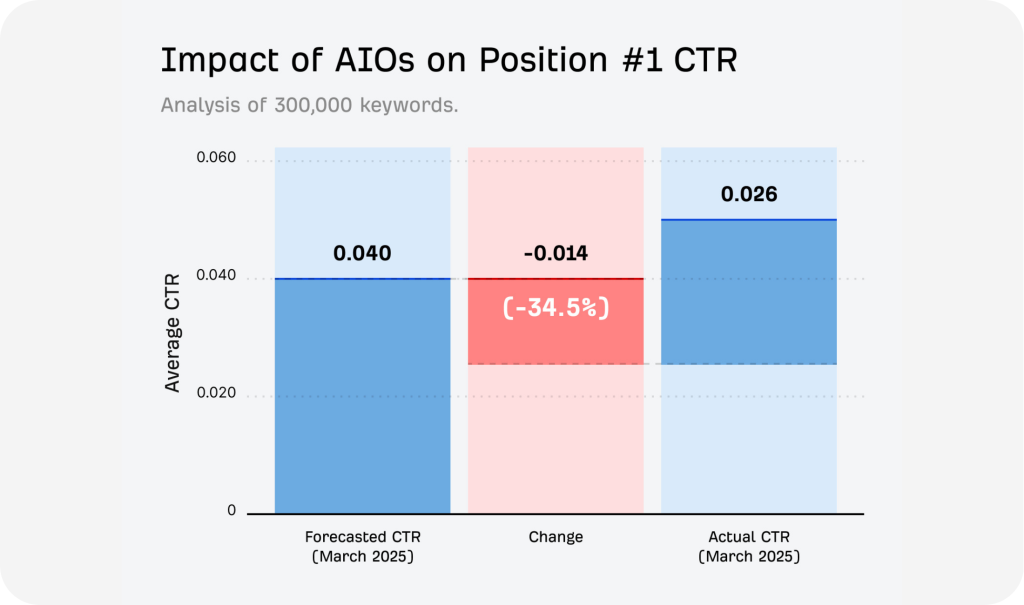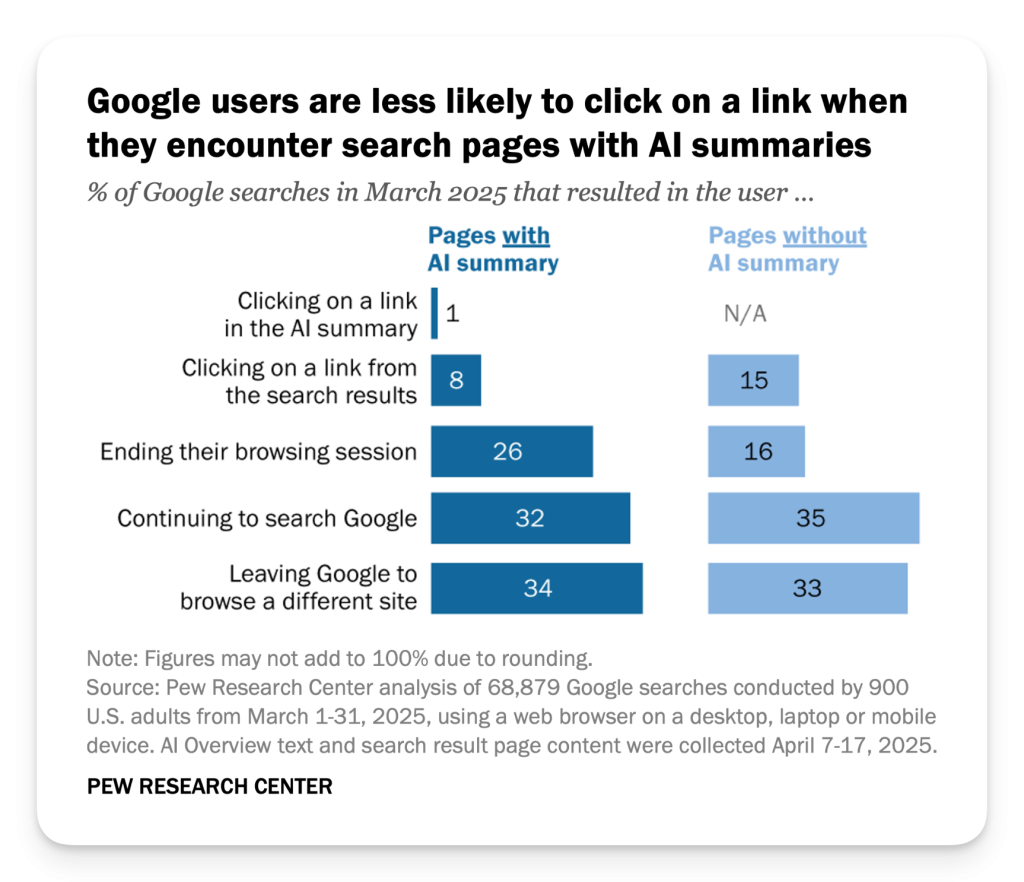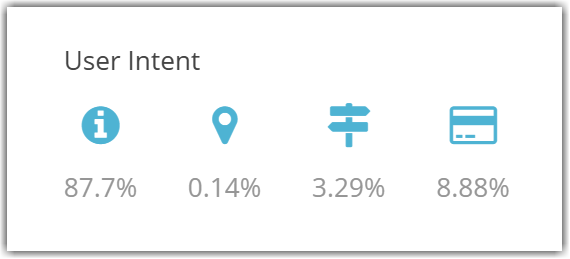Google and AI Overview. The collapse of organic traffic.

Google’s introduction of AI Overview (AIO) isn’t a simple update; it’s the most significant paradigm shift in the digital search ecosystem since its inception. We are witnessing Google’s definitive transition from a “search engine,” which directs traffic to external sources, to an “answer engine,” which aims to satisfy user intent directly within the search results page (SERP). For marketing directors, digital managers, and agencies, this isn’t a theoretical issue—it’s an immediate strategic challenge.

Early quantitative analyses paint a picture that requires careful evaluation: industry studies show an average decline in organic traffic ranging from 18% to over 30% for queries served with AI Overview, with a reduction in Click-Through Rate (CTR) that, according to an Ahrefs analysis on a sample of 300,000 informational keywords (half of which triggered an AI Overview), can reach up to 34.5% for the first organic position. Additionally, while the overall volume of traffic is likely to decrease, the quality and intent of visitors who bypass the AIO to click on a link could increase significantly.

Traditional SEO strategies, obsessively focused on ranking, have become obsolete. Future survival and success require a significant change of course towards a new approach, an evolution of traditional SEO known as “Generative Engine Optimization” (GEO). This new model is built on three interconnected pillars: the systematic demonstration of Experience, Expertise, Authoritativeness, and Trustworthiness (E-E-A-T), the implementation of advanced technical optimizations to ensure machine readability, and the construction of a solid, direct brand equity to reduce strategic dependence on an increasingly volatile channel like Google.
At HT&T Consulting, we are adopting this new approach to best guide our clients through this change.Cos’è l’AI Overview e qual è la sua portata.
What is AI Overview and what is its scope?
AI Overview (AIO) is a feature integrated into Google Search, powered by generative artificial intelligence, that provides structured, synthetic answers directly at the top of the SERP. Unlike traditional Featured Snippets, which merely extract a text fragment from a single source to answer a question, the AIO mechanism is intrinsically more complex and powerful. It synthesizes and combines information from multiple web pages to construct a contextualized and articulated response, often enriched with links, images, and other multimodal elements.
This capability is made possible by advanced language models like Gemini, which integrates multi-step reasoning, planning, and multimodal comprehension abilities. These models allow Google to interpret complex and conversational queries, analyze a vast corpus of web content, and generate a coherent summary that aims to fully satisfy the user’s intent. The introduction of AIO is therefore not an incremental update, but a strategic response to the growing competition from conversational AI tools like ChatGPT, marking a fundamental change in how Google processes and presents information. The goal is no longer just to index the web, but to understand and summarize it.

The Data from Adoption: Explosive Growth
The implementation of this technology has been rapid and volatile. A Semrush analysis revealed that the percentage of SERPs containing an AIO more than doubled in just three months, from 6.49% in January 2025 to 13.14% in March 2025. This volatility has manifested unevenly across various industries. For example, between January and March, the real estate sector saw an increase of 258%, transportation of 223%, and catering of 273%.
The most immediate impact has been a drastic erosion of clicks. A Pew Research Center study highlighted that users are almost twice less likely to click on a link when an AIO is present (a CTR of 8% versus 15% for traditional SERPs). Even more significant, the same research found that only 1% of the time do users click on one of the links cited within the summary itself.

The “Zero-Click” Paradox: Quality vs. Quantity
At first glance, logic suggests that by providing a complete answer directly in the SERP, AIOs should inevitably increase the phenomenon of “zero-click searches,” which are searches that conclude without the user visiting any website. However, the data presents a more nuanced and, in some ways, paradoxical picture.
The Semrush study, analyzing the exact same keywords before and after the introduction of AIOs, found that the zero-click rate actually decreased slightly, from 38.1% to 36.2%.
This apparent contradiction is the key to understanding the true nature of the change underway. It is not a simple elimination of traffic, but a profound bifurcation:
Low-intent traffic, which is primarily informational, is absorbed and satisfied directly by Google through the AIO. This is the volume that most sites will lose.
High-intent traffic, which “survives” the AIO filter and results in a click, is inherently more qualified. This is a user who is looking for greater depth, supporting data, a visual experience, or to execute a transaction.
The strategic consequence is a necessary shift in success metrics: raw traffic volume will become a “vanity metric,” while the focus must shift to the conversion rate and the value per visit of the surviving traffic.
The Most Affected Sectors (and the Ones that Resist)
The impact of this evolution on traffic is not uniform but varies significantly based on the sector and, especially, on search intent. Informational queries are the most exposed: a seoClarity study found that about 88% of AIOs appear for this type of search. Consequently, the most affected sectors are those whose value proposition is based on providing direct information that can be easily synthesized by the AI. These include:
Healthcare: where frequently asked questions about symptoms or conditions receive direct answers.
Personal finance: where comparisons and basic explanations are effectively summarized.
Education and technology: where guides and tutorials often no longer require a click to be understood at a superficial level.
However, content and sectors where the user has a more decisive intent or requires direct interaction with the site resist, and in some cases can even benefit from more qualified traffic. These include:
Highly transactional content (e.g., eCommerce): the user still needs to visit the site to view product galleries, read detailed reviews, and complete a purchase.
Local searches: the search for a professional or a service in the area implies the need to view maps, hours, and direct contacts.
Specific branded requests: when the user is looking for a specific brand, their intent is navigational and directed towards the official website.
However, it is crucial to monitor the situation: the same seoClarity study shows a slow but steady growth in the presence of AIOs even for transactional keywords, which reached 8.9% in March 2025.

A New Paradigm: From the Race for Ranking to Conquering AI’s Trust
The most profound change introduced by AI Overview concerns the very definition of success in organic search. For decades, the primary goal of SEO has been to conquer the top positions. Today, this goal is insufficient. The AIO occupies the most valuable space on the SERP, pushing traditional organic results “below the fold” and causing a drastic drop in visibility and CTR.
The new strategic goal is no longer to be the first link, but to become the authoritative source chosen by artificial intelligence to build its response. Visibility is now also measured in “citations.” Being included in the AIO, even without a direct click, becomes a primary indicator of relevance and authority, transforming SEO from a discipline focused on traffic to a strategic function for building algorithmic authority.
This is linked to a change in user behavior, as they are getting used to conversational search. Queries are no longer keyword strings but complex questions in natural language (e.g., “What are the best low-cost laptops with a battery that lasts all day?”). The user expects an immediate and complete answer, which the AIO aims to provide.
Reinventing SEO. The Strategic Framework We Use at HT&T Consulting
To successfully navigate this new landscape, we are adopting a proactive “Generative Engine Optimization” (GEO) framework based on three fundamental pillars.
1. Content Strategy: From Keywords to “Semantic Entities” Modern SEO must evolve from a purely keyword-driven logic to a semantic and contextual one. What matters is no longer “ranking for a keyword,” but being authoritative enough to be chosen to compose an answer. The strategy must be based on topics, developing content clusters that cover a theme exhaustively. As Google emphasizes, the goal is to create unique, “people-first” content.
The content structure becomes just as important as its substance. To be “readable” by machines, content must be impeccably organized, with a clear hierarchy of headings (H1, H2, H3) and an adaptive, almost editorial tone of voice. Finally, to incentivize the click, content must offer unique added value that is not easily summarized: original analysis, proprietary data, case studies, or interactive tools.
2. Adopting E-E-A-T to Build Algorithmic Trust Google’s E-E-A-T (Experience, Expertise, Authoritativeness, Trustworthiness) framework is no longer a simple guideline but becomes the primary filtering mechanism for source selection by AI Overviews. Demonstrating these attributes becomes the most critical SEO activity:
Experience: the content must reflect practical, direct knowledge.
Expertise: it is essential to show authority through identifiable authors with biographies that highlight their qualifications.
Authoritativeness: authority is built by earning mentions and backlinks from other respected sites. A solid Digital PR strategy is essential.
Trustworthiness: trust is built through accuracy, transparency, and constant updating of content.
3. Advanced Technical SEO While content strategy and E-E-A-T define “what” to say, technical SEO defines “how” to say it in a way that machines can understand without ambiguity. The technical requirements for traditional search are also valid and fundamental for AI experiences:
Solid Technical Foundations: Ensuring the site is crawlable, fast (passing Core Web Vitals), and mobile-friendly are non-negotiable prerequisites.
Structured Data (schema markup): Implementing advanced structured data (e.g., FAQPage, HowTo, Article) is a fundamental requirement to provide Google with an explicit context about the nature of the content. It is essential that all data in the markup is also visible on the page for the user, so as not to violate the guidelines.
Visibility Management with Preview Controls: Google offers technical tools like nosnippet, max-snippet, and data-nosnippet tags to manage how content appears in search results. A strategic use of these controls can help provide a sufficient preview to pique interest without revealing the entire value of the content, thus encouraging the click.
Multimodal Optimization: Google’s AI experiences are not limited to text. It is crucial to support content with high-quality images and videos, optimized with descriptive alt text, and to keep information updated on platforms like Google Merchant Center and Google Business Profile.
The Evolution of Metrics
The AIO era requires a radical rethinking of the Key Performance Indicators (KPIs) used to measure success. Traditional metrics such as ranking for non-branded keywords and raw organic click volume are losing their meaning. It is necessary to adopt a new metrics dashboard that reflects the new reality:
Share of Voice in AIOs: The frequency with which the brand is cited as a source in AI answers.
Branded Search Growth: The increase in searches that contain the brand name.
Direct Traffic: The volume of users who access the site by bypassing search engines.
Conversion Metrics: In-depth analysis of the behavior of the surviving organic traffic, which should be more qualified and likely to convert.
Navigating Disruption and Driving the Future of Online Search
The introduction of AI Overview is a point of no return that redefines the rules of the digital game. The threat of a decline in “mass” traffic is real and requires immediate action. However, this disruption is not just a threat but also a powerful catalyst for a necessary evolution of digital marketing.
The AIO era forces companies to focus on creating superior quality content, building genuine authority, developing direct relationships with their audience, and optimizing their online ecosystem.
The future of online visibility will not belong only to those who are most skilled at exploiting the algorithm but also to those who unequivocally demonstrate their competence in terms of communication and digital presence.
The search revolution is underway, and at HT&T Consulting, we have been working for some time, together with our clients, to make the most of the opportunities offered by this change.

The future of online visibility will not belong only to those who are most skilled at exploiting the algorithm but also to those who unequivocally demonstrate their competence in terms of communication and digital presence.
The search revolution is underway, and at HT&T Consulting, we have been working for some time, together with our clients, to make the most of the opportunities offered by this change.
Bibliography
Ahrefs. (2025). AI Overviews Reduce Clicks by 34.5%. https://ahrefs.com/blog/ai-overviews-reduce-clicks/
Pew Research Center. (2025). Google users are less likely to click on links when an AI summary appears in the results. https://www.pewresearch.org/short-reads/2025/07/22/google-users-are-less-likely-to-click-on-links-when-an-ai-summary-appears-in-the-results/
SEOZoom. (2025). Web traffic: Google Search continues to grow, AI engines follow. https://www.seozoom.com/web-traffic-data-analysis/
Semrush. (2025). AI Overviews Study: Inside Google’s New Search Reality. https://www.semrush.com/blog/semrush-ai-overviews-study/
AGI. (2025). Google, l’AI e il traffico web che scompare. https://www.agi.it/innovazione/news/2025-07-25/google-ai-overviews-calo-traffico-web-32446484/
seoClarity. (2025). AI Overviews: Impact and Strategies for SEO. https://www.seoclarity.net/research/ai-overviews-impact
Google. (2025). Avere successo nella Ricerca Google con le nostre funzionalità basate sull’IA. https://developers.google.com/search/docs/appearance/ai-features?hl=it
Continua a leggere
And it consumes less energy.
To return to the page you were visiting, simply click or scroll.


